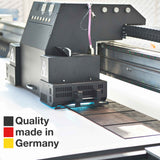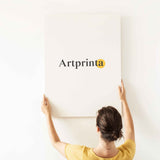Gustave Moreau, 1864 - Oedipus and the Sphinx - fine art print
Tax included. Shipping calculated at checkout.
Additional description by the museum's website (© - by The Metropolitan Museum of Art - www.metmuseum.org)
The legendary Greek prince Oedipus confronts the malevolent Sphinx, who torments travelers with a riddle: What creature walks on four legs in the morning, two legs at noon, and three legs in the evening? Remains of victims who answered incorrectly litter the foreground. (The solution is the human, who crawls as a baby, strides upright in maturity, and uses a cane in old age.) Moreau made his mark with this painting at the Paris Salon of 1864. Despite the growing prominence of depictions of everyday life, he portrayed stories from the Bible, mythology, and his imagination. His otherworldly imagery inspired many younger artists and writers, including Odilon Redon and Oscar Wilde.
Structured artwork data
| Work of art name: | "Oedipus and the Sphinx" |
| Classification of the artwork: | painting |
| Generic term: | modern art |
| Time: | 19th century |
| Artwork year: | 1864 |
| Artwork age: | 150 years old |
| Original medium of artwork: | oil on canvas |
| Original dimensions: | 81 1/4 x 41 1/4 in (206,4 x 104,8 cm) |
| Exhibited in: | The Metropolitan Museum of Art |
| Location of the museum: | New York City, New York, United States of America |
| Museum's web page: | The Metropolitan Museum of Art |
| License of artwork: | public domain |
| Courtesy of: | The Metropolitan Museum of Art, New York, Bequest of William H. Herriman, 1920 |
| Creditline: | Bequest of William H. Herriman, 1920 |
Artist overview
| Name of the artist: | Gustave Moreau |
| Also known as: | Moreau Gustave, G. Moreau, moreau gustave, Moreau, Gustave Moreau, מורו גוסטב, ギユスターヴ |
| Gender of the artist: | male |
| Nationality: | French |
| Jobs of the artist: | painter, sculptor |
| Home country: | France |
| Artist category: | modern artist |
| Art styles: | Symbolism |
| Died at the age of: | 72 years |
| Year born: | 1826 |
| City of birth: | Paris, Ile-de-France, France |
| Year of death: | 1898 |
| Town of death: | Paris, Ile-de-France, France |
Item information
| Article categorization: | fine art print |
| Reproduction method: | digital reproduction |
| Production process: | UV direct print |
| Production: | Germany |
| Type of stock: | on demand |
| Intended product use: | wall picture, wall gallery |
| Orientation: | portrait alignment |
| Side ratio: | 1 : 2 - (length : width) |
| Side ratio interpretation: | the length is 50% shorter than the width |
| Available choices: | poster print (canvas paper), metal print (aluminium dibond), canvas print, acrylic glass print (with real glass coating) |
| Canvas on stretcher frame (canvas print) size variants: | 20x40cm - 8x16", 30x60cm - 12x24", 40x80cm - 16x31", 50x100cm - 20x39", 60x120cm - 24x47", 80x160cm - 31x63", 90x180cm - 35x71" |
| Acrylic glass print (with real glass coating) options: | 20x40cm - 8x16", 30x60cm - 12x24", 40x80cm - 16x31", 50x100cm - 20x39", 60x120cm - 24x47", 80x160cm - 31x63", 90x180cm - 35x71" |
| Poster print (canvas paper) size variants: | 30x60cm - 12x24", 40x80cm - 16x31", 50x100cm - 20x39", 60x120cm - 24x47" |
| Aluminium dibond print options: | 20x40cm - 8x16", 30x60cm - 12x24", 40x80cm - 16x31", 50x100cm - 20x39", 60x120cm - 24x47" |
| Picture frame: | not included |
Pick a item material variant
For every art print we offer a range of different sizes and materials. The following options are available for individualization:
- The poster print (canvas material): The Artprinta poster print is a printed cotton canvas with a slight finish on the surface, that reminds the original masterpiece. Please keep in mind, that depending on the size of the poster print we add a white margin of around 2-6cm around the work of art, which facilitates the framing.
- Canvas print: A UV printed canvas material stretched on a wooden frame. In addition to that, a canvas print creates a cosy and positive impression. The advantage of canvas prints is that they are relatively low in weight. That means, it is easy to hang the Canvas print without extra wall-mounts. Canvas prints are suitable for any type of wall.
- Aluminium dibond print: Aluminium Dibond prints are metal prints with an impressive depth effect. For our Aluminium Dibond print, we print the favorite artpiece right on the surface of the white-primed aluminum. The white & bright components of the original artwork shimmer with a silk gloss but without glow. The colors of the print are bright and vivid, fine details of the print are clear and crisp, and you can literally perceive a matte appearance of the art print surface.
- Printed acrylic glass: An print on acrylic glass, often referenced as a plexiglass print, transforms your favorite artwork into brilliant home décor and offers a great alternative option to dibond or canvas fine art replicas. With an acrylic glass art print contrasts as well as details become more recognizeable thanks to the very subtle gradation in the picture.
This over 150 year-old artwork was created by the artist Gustave Moreau. The original version had the following size - 81 1/4 x 41 1/4 in (206,4 x 104,8 cm). Oil on canvas was applied by the French painter as the medium of the work of art. This piece of art is included in the digital art collection of The Metropolitan Museum of Art in New York City, New York, United States of America. This modern art public domain piece of art is being included with courtesy of The Metropolitan Museum of Art, New York, Bequest of William H. Herriman, 1920. Besides, the work of art has the following creditline: Bequest of William H. Herriman, 1920. In addition to this, the alignment is in portrait format and has a side ratio of 1 : 2, which implies that the length is 50% shorter than the width. The painter, sculptor Gustave Moreau was an artist, whose art style can mainly be classified as Symbolism. The artist lived for a total of 72 years, born in 1826 in Paris, Ile-de-France, France and passed away in the year 1898 in Paris, Ile-de-France, France.
Important information: We try the best we can to depict our art products in as much detail as possible and to showcase them visually on the product detail pages. However, the colors of the print materials and the printing may differ marginally from the image on the device's screen. Depending on your screen settings and the nature of the surface, not all colors can be printed one hundret percent realistically. Bearing in mind that all the fine art prints are processed and printed manually, there may also be minor deviations in the motif's exact position and the size.
This text is intellectual property and protected by copyright ©, Artprinta (www.artprinta.com)














